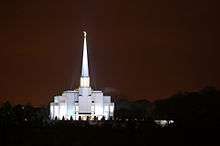The Church of Jesus Christ of Latter-day Saints in Scotland
The Church of Jesus Christ of Latter-day Saints reported 26,536 members in five stakes, 41 congregations (27 wards, 14 branches), one mission, and no temples in Scotland as of 1 January 2009.[1][2] The 2011 government census had 4,651.[3]
History
First Missionaries in Scotland
Wright and Mulliner
Two native Scots, Alexander Wright and Samuel Mulliner, became the first missionaries to Scotland after they were converted whilst living in Ontario, Canada, arriving 20 December 1839.[4] The elders began teaching the gospel to their own families, so they traveled to Edinburgh to visit Elder Mulliner's parents. After Wright traveled to Marnock in Banffshire to share the gospel with his family despite suffering from smallpox.[5] The two elders reunited and began preaching systematically in Glasgow.[5] On 14 January 1840 Mulliner baptised the first converts in Scotland, Alexander Hay and his wife Jessie, in the River Clyde at Bishopton near Paisley.[4] Mulliner and Wright reunited and on 2 February 1840 baptised two young men from Leith.[6] They taught in the area until they were forced to leave due to abuse and persecution.[4]
Orson Pratt's missionary efforts
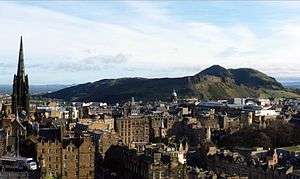
Orson Pratt arrived in Scotland on 8 May 1840 to supervise the missionaries. At the time of Pratt's arrival, there were 80 Latter-day Saints in the area.[4] Due to his missionary efforts, a branch of the church in Paisley.[7] Pratt dedicated Scotland "for the preaching of the gospel" at Arthur's Seat, a hill in Holyrood Park, Edinburgh.[8][9] Pratt called two more missionaries to the area: Hiram Clark and Reuben Hedlock. They worked alongside Wright in Paisley, while Pratt and Mulliner began proselyting in Edinburgh. Mulliner would return to the United States in 1840.[5]
Pratt and Wright preached in every night in the streets of the city, and were able to baptise 23 new converts by the end of the summer on 1840. Pratt was unsatisfied with their success in the area and decided to try a new approach: writing.[5] While in Edinburgh, Pratt wrote and published the pamphlet An Interesting Account of Several Remarkable Visions. It included the first published account of Joseph Smith’s first vision, and with the scriptures, became a standard Church publication in Scotland.[10] Pratt distributed this pamphlet for 10 months until he returned home in March 1841, leaving the mission under George D. Watt. Pratt would later return to Scotland throughout this life to visit the saints there. Wright remained in Scotland until 1842. Due to the efforts of these early missionaries, there were 70 branches by 1848,[5] and by 1853 the church had grown to over 3,000 members.[4]
Church decline in the late 19th century
Early church members were usually workers in industrial areas who turned to religion out of a "reflex of despair." Few Highlanders joined the church. With an increase in church membership, there were four conferences held in Scotland in Glasgow, Kilmarnock, Edinburgh, and Dundee between 1855 and 1859. This church growth did not go unnoticed. Some of the church members in the mid-19th century were persecuted. Violent acts occurred in Kirkpatrick when members were stoned, and also in Busby where mobs gathered. In 1850 Scots law "prohibited the disruption of religious assemblies" to avoid violence in Edinburgh.[11]
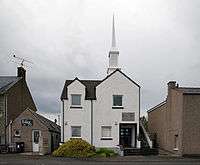
Despite these strong early beginnings, the church would face a decline in membership after the 1850s due to a number of factors. The church had encouraged members to join with the Saints in the United States and emigrate to Utah. In the 1850s, 1,800 church members emigrated to the U.S. and approximately 1,600 members emigrated during the next decade. Missionaries during this time period also reported that fewer people were interested in learning about the church and there was a "spirit of indifference," perhaps attributed to the reformations and revitalisation of the Church of Scotland. Large groups of church members were also excommunicated for violations of church standards. Scotland was also in a depression during this time which could have contributed to church decline, along with other potential factors. Mormonism was effectively stagnant until the 1960s when new social and economic conditions were established in the country.[11]
1950s to present
Beginning in the 1950s emigration to the United States began to be discouraged and local congregations began to proliferate. The members in Scotland were in the British Mission until it was split in 1960; they then became part of the North British Mission. The following year the Scottish-Irish Mission was formed, which was later divided. The first stake was formed in Glasgow in 1962, and 13 years later the second stake was established in Dundee.[4] The Scottish mission has since been merged back in with the Irish one.
Today, church members in Scotland participate in all church auxiliary programs including seminary and institute, and many of the young LDS men and women serve missions for the church.[4]
In 2020, the LDS Church canceled services and other public gatherings indefinitely in response to the spread of the coronavirus pandemic.[12]
Membership
LDS Membership statistics
| Year | Membership | Stakes | Wards | Branches | Total Congregations | Missions | Temples |
|---|---|---|---|---|---|---|---|
| 2009[2] | 26,536 | 5 | 27 | 14 | 41 | 1 | 0 |
| 2016[1] | 13,743 | 5 | 26 | 13 | 39 | 1 | 0 |
However the 2011 census found only 4,651 Scots who identified as Latter Day Saints.[3]
Missions
There is currently a single mission serving Scotland, which is shared with Ireland:
- Scotland/Ireland Mission
Five out of the six British Isles missions are based in England.
Temples
There are no LDS temples in Scotland itself.
Both of the UK/British Isles temples are in England. The Preston temple serves Scotland, and the London one did until 1997.
|
|
52. Preston England Temple | ||
|
Location: |
Chorley, Lancashire, England, United Kingdom | ||
Notable Scottish Latter-day Saints
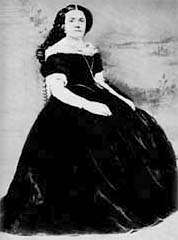
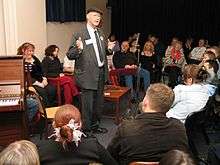
- Brian Adam — first Latter-day Saint member of the Scottish Parliament, and later became a government minister
- David S. Baxter, First Quorum of the Seventy, born in Scotland, moved to England as a child.
- Eilley Bowers, born in Scotland, emigrated to the United States after becoming a Latter-Day Saint. She was, in her time, one of the richest women in the United States though she died penniless.
- Johnny Cunningham, folk musician in Silly Wizard, brother of Phil (left the church)
- Phil Cunningham, accordionist and folk musician. (left the church)
- John Lyon, poet and writer of the American frontier.
- Stanley Robertson, master storyteller, ballad singer and author of several books of Lowland Traveller tales.[13]
- Robert Sands (conductor), born in Ireland, but converted while living in Scotland.
- Jane McKechnie Walton, born in Scotland, emigrated to the United States as a young child after her family converted.
See also
References
- http://apps.charitycommission.gov.uk/Accounts/Ends51/0000242451_AC_20151231_E_C.pdf Charities Commission Report for LDS Church in 2015. Retrieved 15 August 2017.
- "Country information: United Kingdom", Church News Online Almanac, Deseret News, 1 February 2010, retrieved 18 October 2012
- "Religion (detailed)" (PDF). Scotland's Census 2011. National Records of Scotland. Retrieved 12 April 2015. Note that the choices were None, Church of Scotland, Roman Catholic, Other Christian, Muslim, Buddhist, Sikh, Jewish, Hindu, and Another religion or body. Those answering Other Christian or Another religion were asked to write which one.
- Cuthbert, Muriel (October 1978). "The Saints around the World: Strong Saints in Scotland". Ensign.
- England, Breck (February 1987). "Gospel Seeds in Scottish Soil". Ensign.
- Mulliner, Samuel. "Samuel Mulliner History".
- Mays, Kenneth (12 December 2012). "Picturing history: Paisley, Scotland". Deseret News. Retrieved 5 January 2014.
- Evans, Richard L. (1984) [1937]. A Century of "Mormonism" in Great Britain. Salt Lake City: Publishers Press. ISBN 091609507X. OCLC 866138200.
- Whittaker, David J.; Esplin, Ronald K.; Allen, James B., eds. (1992), "Orson Pratt in Scotland", Men with a mission, 1837-1841: the Quorum of the Twelve Apostles in the British Isles, Salt Lake City, Utah: Deseret Book, ISBN 978-0-87579-546-1, OCLC 24375869
- Whittaker, David J. (Fall 2004). "Mormon Historic Studies" (PDF). Mormon Historic Studies: 79–100.
- Buchanan, Frederick S. "The ebb and Flow of Mormonism in Scotland, 1840-1900": 27–52. Cite journal requires
|journal=(help) - Lovett, Ian. "Mormon Church Cancels Services World-Wide Amid Coronavirus Crisis", The Wall Street Journal, 12 March 2020. Retrieved on 3 April 2020.
- Schofield, Derek (7 October 2009). "Stanley Robertson obituary". the Guardian. Retrieved 7 May 2018.
External links
| Wikimedia Commons has media related to The Church of Jesus Christ of Latter-day Saints in Scotland. |
- Newsroom (United Kingdom & Ireland)
- The Church of Jesus Christ of Latter-day Saints (UK and Ireland) – Official Site
- Joseph Smith Papers "An Interesting Account of Several Remarkable Visions, 1840"

